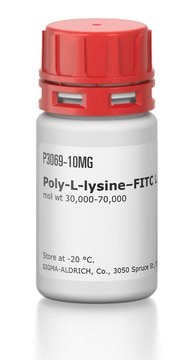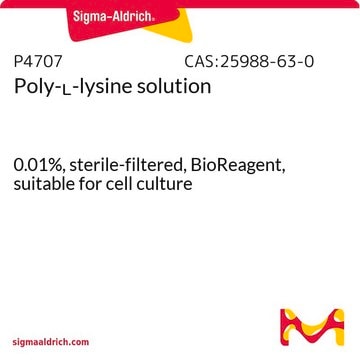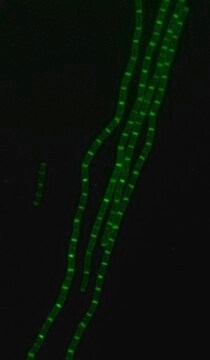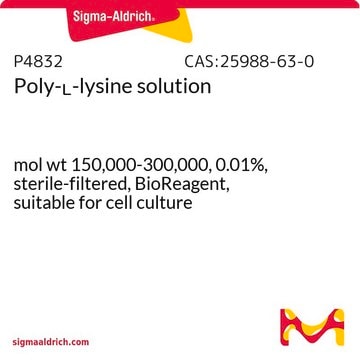The viscosity average molecular weight (Mv) is determined for each lot of this product. However, there is a distribution of molecular weights around that Mv. As a result, the molar concentration is not applicable. The typical degree of polymerization (DP) for this material is approximately 100 and the typical degree of substitution (moles of FITC per mole of lysine) is approximately 0.007 or 7 per 1000; essentially 7 of 10 Poly-L-Lysine molecules contain one FITC label. The concentration of the solution may be most accurately determined by precisely weighing the sample and precisely determining the volume, so that the sample may be reported as mg/mL. The degree of substitution and degree of polymerization are lot specific and reported in the product Certificate of Analysis. Please see the link below to review a sample of lot specific Certificate:
https://www.sigmaaldrich.com/product/sigma/p3543#product-documentation
P3543
Poly-L-lysine–FITC Labeled
mol wt 15,000-30,000
Synonyme(s) :
Fluorescein Labeled Poly-L-Lysine
About This Item
Produits recommandés
Forme
powder
Poids mol.
precursor poly-L-lysine • HBr 15,000-30,000
15,000-30,000
Ampleur du marquage
0.003-0.01 mol FITC per mol lysine monomer
Couleur
yellow to orange
Température de stockage
−20°C
Vous recherchez des produits similaires ? Visite Guide de comparaison des produits
Catégories apparentées
Autres remarques
Code de la classe de stockage
11 - Combustible Solids
Classe de danger pour l'eau (WGK)
WGK 3
Point d'éclair (°F)
Not applicable
Point d'éclair (°C)
Not applicable
Équipement de protection individuelle
Eyeshields, Gloves, type N95 (US)
Faites votre choix parmi les versions les plus récentes :
Certificats d'analyse (COA)
Vous ne trouvez pas la bonne version ?
Si vous avez besoin d'une version particulière, vous pouvez rechercher un certificat spécifique par le numéro de lot.
Déjà en possession de ce produit ?
Retrouvez la documentation relative aux produits que vous avez récemment achetés dans la Bibliothèque de documents.
Les clients ont également consulté
Articles
Humankind has utilized protein materials throughout its existence, starting with the use of materials such as wool and silk for warmth and protection from the elements and continuing with the use of recombinant DNA techniques to synthesize proteins with unique and useful properties.
-
ow do you determine the peptide concentration of a small scoop in solution? I am reading the absorbance at 495nm to read the fluorophore but I don't know how to convert that Absorbance value to a meaningful mg/mL or molarity concentration without an e.c.
1 réponse-
Utile ?
-
-
How much FITC quantity or weight percentage is present per mg of the mixture? If 10 mg of the product is weighed out, what portion of the weight corresponds to the PLL?
1 réponse-
The FITC quantity present per mg of the mixture is 0.016 mg, which corresponds to approximately 1.6% of the weight. If 10 mg of the product is weighed out, the portion of the weight corresponding to the PLL is approximately 9.84 mg.
Utile ?
-
Filtres actifs
Notre équipe de scientifiques dispose d'une expérience dans tous les secteurs de la recherche, notamment en sciences de la vie, science des matériaux, synthèse chimique, chromatographie, analyse et dans de nombreux autres domaines..
Contacter notre Service technique









